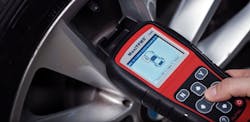There are roughly 103 million vehicles on the road today equipped with a tire pressure monitoring system. Offering the servicing of these systems to your customers will not only result in a new revenue stream but also will improve customer retention as you educate them about this vital vehicle safety system.
What is TPMS and when did automakers start adding the system to their vehicles?
TPMS stands for “tire pressure monitoring systems” and while a few automakers such as Porsche and Cadillac were early voluntary adopters, the federal government, in an effort to improve vehicle safety, made TPMS a mandatory system on all cars and light weight trucks on the road beginning September 1, 2007. Under the Transportation Recall Enhancement, Accountability, and Documentation (TREAD) act, automakers needed to include a system on its vehicles that would detect and alert drivers to low air pressure—25 percent of the OE-specified—on one or more of the tires.
Is TPMS an effective safety feature?
A resounding “yes.” Plus, the systems are money savers, too. According to the National Highway Traffic Safety Administration, TPMS saves 660 lives per year, prevents 33,000 injuries and saves $511 million worth of gas.
What is the difference between a steady TPMS light and one that flashes?
A steady TPMS light indicates that one or more of the tires is below the recommended air pressure value. When the air pressure is adjusted to the placard value posted on the driver’s door jamb, the light should no longer display.
A flashing TPMS light—flashes for about 30 to 90 seconds and then lights solid—upon starting the vehicle that indicates that there is something wrong with the vehicle’s tire pressure monitoring system. The components of a direct systems include the module, sensors and one or more antennas.
How does TPMS work?
There are two types of TPMS: direct and indirect systems.
The direct system features a pressure sensor/transmitter on each tire that periodically measures the air pressure on the wheel and transmits that information to the vehicle’s TPMS module. If the pressure is off by 25 percent, a TPMS light will display. Vehicles with high-line systems will display the location of the tire with low pressure.
The indirect system does not use sensors but rather uses the wheel speed sensor of the anti-lock braking system (ABS) to compare the relative speed of one tire to another. If a tire’s pressure is low, it will roll at a different speed than the other tires. The vehicle’s ECU will detect this discrepancy and display a TPMS malfunction indicator light (MIL) on the dash.
What is involved in servicing a direct TPMS?
The most vulnerable components of the direct TPMS are the sensors. Visually inspect each wheel sensor for damage. The sensors are ripe for corrosion as they are exposed to salt, water, ferrous brake dust, extreme temperatures and significant vibrations. While inspecting for physical damage, which is the main culprit of sensor failure, use a TPMS tool to test the battery strength. Sensor batteries last on an average of between five and seven years. If the sensor needs to be replaced, remove the tire from the rim. Remove damaged or non-functioning TPMS sensors. Next, install the programmed replacement sensor.
If the replacement sensor has a different ID from the previous sensor installed on the tire, the new ID must be registered (Relearned) to the vehicle module; The system uses the IDs to recognize the sensor and its associated tire’s pressure.
What are the types of TPMS sensors?
There are three aftermarket sensor types: direct replacement, multi-protocol, and programmable. Direct replacement sensors are purchased pre-programmed with the protocol of the original OE sensor— a direct, one -to-one fitment replacement. Multi-protocol sensors are also pre-programmed but with multiple vehicle protocols. Programmable sensors are purchased blank to be programmed with a TPMS tool to replace the OE sensor.
What are the three Relearn methods and what is involved in each?
A good TPMS tool will display the relearn procedure for the specific vehicle entered by make, model and model year in tool. The vehicle manufacturer determines the relearn for each vehicle. There are three relearn types, stationary, dynamic, OBDII, though some vehicles require performing one method in conjunction with another.
The stationary method involves putting the vehicle in “relearn” mode and activating the sensors. The dynamic or auto relearn involved driving the vehicle for specific length of time and the OBDII relearn method involves connecting the TPMS tool to the OBDII port.
What would I need to invest in to offer TPMS as a service?
To offer TPMS service, a shop needs a dedicated TPMS tool, TPMS sensors and TPMS rebuild kits (valve caps, screws, valve cores). However, there is a world of difference between simply offering the service and positioning your shop to make TPMS servicing an efficient and lucrative new revenue stream.
Autel, a leading developer of automotive diagnostic scan tools, has been in the TPMS industry for close to a decade and offers a comprehensive approach to TPMS service. Autel offers advanced, yet easy-to-use TPMS tools and the aftermarket industry-leader, the 1-Sensor—a dual frequency, universal programmable sensor that boasts the ability to be programmed to replace 99 percent of the sensors on road today. No need to stock hundreds of sensors or wait on the parts shop to deliver.
The 1-Sensor is available in metal and rubber press-in secure/release valves and a screw-in adjustable valve stem. No other company in the industry develops both sensors and tools, making Autel’s sensor software coverage quicker-to-market and more accurate than other aftermarket programmable sensors.
For more information call 855.288.3587, email [email protected], or visit autel.com, maxitpms.com, maxisysadas.com
